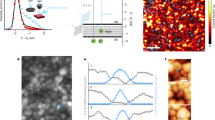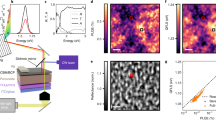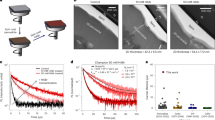Abstract
Understanding the nanoscopic chemical and structural changes that drive instabilities in emerging energy materials is essential for mitigating device degradation. The power conversion efficiency of halide perovskite photovoltaic devices has reached 25.7 per cent in single-junction and 29.8 per cent in tandem perovskite/silicon cells1,2, yet retaining such performance under continuous operation has remained elusive3. Here we develop a multimodal microscopy toolkit to reveal that in leading formamidinium-rich perovskite absorbers, nanoscale phase impurities, including hexagonal polytype and lead iodide inclusions, are not only traps for photoexcited carriers, which themselves reduce performance4,5, but also, through the same trapping process, are sites at which photochemical degradation of the absorber layer is seeded. We visualize illumination-induced structural changes at phase impurities associated with trap clusters, revealing that even trace amounts of these phases, otherwise undetected with bulk measurements, compromise device longevity. The type and distribution of these unwanted phase inclusions depends on the film composition and processing, with the presence of polytypes being most detrimental for film photo-stability. Importantly, we reveal that both performance losses and intrinsic degradation processes can be mitigated by modulating these defective phase impurities, and demonstrate that this requires careful tuning of local structural and chemical properties. This multimodal workflow to correlate the nanoscopic landscape of beam-sensitive energy materials will be applicable to a wide range of semiconductors for which a local picture of performance and operational stability has yet to be established.
This is a preview of subscription content, access via your institution
Access options
Access Nature and 54 other Nature Portfolio journals
Get Nature+, our best-value online-access subscription
$29.99 / 30 days
cancel any time
Subscribe to this journal
Receive 51 print issues and online access
$199.00 per year
only $3.90 per issue
Buy this article
- Purchase on Springer Link
- Instant access to full article PDF
Prices may be subject to local taxes which are calculated during checkout



Similar content being viewed by others
Data availability
The data that support the findings of this study are available at https://doi.org/10.17863/CAM.85310 or from the corresponding authors upon request.
References
Best research-cell efficiency chart. Best research-cell efficiency chart. NREL https://www.nrel.gov/pv/cell-efficiency.html (2022).
Jošt, M., Kegelmann, L., Korte, L. & Albrecht, S. Monolithic perovskite tandem solar cells: a review of the present status and advanced characterization methods toward 30% efficiency. Adv. Energy Mater. 10, 1904102 (2020).
Li, N., Niu, X., Chen, Q. & Zhou, H. Towards commercialization: the operational stability of perovskite solar cells. Chem. Soc. Rev. 49, 8235–8286 (2020).
Miller, O. D., Yablonovitch, E. & Kurtz, S. R. Strong internal and external luminescence as solar cells approach the Shockley–Queisser limit. IEEE J. Photovolt. 2, 303–311 (2012).
Doherty, T. A. S. et al. Performance-limiting nanoscale trap clusters at grain junctions in halide perovskites. Nature 580, 360–366 (2020).
Orri, J. F. et al. Unveiling the interaction mechanisms of electron and X-ray radiation with halide perovskite semiconductors using scanning nano-probe diffraction. Adv. Mater. 34, 2200383 (2022).
Saliba, M. et al. Cesium-containing triple cation perovskite solar cells: improved stability, reproducibility and high efficiency. Energy Environ. Sci 9, 1989–1997 (2016).
Al-Ashouri, A. et al. Monolithic perovskite/silicon tandem solar cell with >29% efficiency by enhanced hole extraction. Science 370, 1300–1309 (2020).
Andaji‐Garmaroudi, Z., Anaya, M., Pearson, A. J. & Stranks, S. D. Photobrightening in lead halide perovskites: observations, mechanisms, and future potential. Adv. Energy Mater. 10, 1903109 (2020).
Tress, W. et al. Interpretation and evolution of open-circuit voltage, recombination, ideality factor and subgap defect states during reversible light-soaking and irreversible degradation of perovskite solar cells. Energy Environ. Sci. 11, 151–165 (2018).
Alberti, A. et al. Pb clustering and PbI2 nanofragmentation during methylammonium lead iodide perovskite degradation. Nat. Commun. 10, 2196 (2019).
Lin, Y.-H. et al. A piperidinium salt stabilizes efficient metal-halide perovskite solar cells. Science 369, 96–102 (2020).
Shao, S. & Loi, M. A. The role of the interfaces in perovskite solar cells. Adv. Mater. Interfaces 7, 1901469 (2020).
Kosar, S. et al. Unraveling the varied nature and roles of defects in hybrid halide perovskites with time-resolved photoemission electron microscopy. Energy Environ. Sci. 14, 6320–6328 (2021).
Palosz, B. The structure of PbI2 polytypes 2H and 4H: a study of the 2H–4H transition. J. Phys. Condens. Matter 2, 5285–5295 (1990).
Meggiolaro, D. et al. Iodine chemistry determines the defect tolerance of lead-halide perovskites. Energy Environ. Sci. 11, 702–713 (2018).
Motti, S. G. et al. Controlling competing photochemical reactions stabilizes perovskite solar cells. Nat. Photon. 13, 532–539 (2019).
Samu, G. F. et al. Electrochemical hole injection selectively expels iodide from mixed halide perovskite films. J. Am. Chem. Soc. 141, 10812–10820 (2019).
Frolova, L. A. et al. Reversible Pb2+/Pb0 and I−/I3− redox chemistry drives the light-induced phase segregation in all-inorganic mixed halide perovskites. Adv. Energy Mater. 11, 2002934 (2021).
Azpiroz, J. M., Mosconi, E., Bisquert, J. & Angelis, F. D. Defect migration in methylammonium lead iodide and its role in perovskite solar cell operation. Energy Environ. Sci. 8, 2118–2127 (2015).
Baltog, I., Piticu, I., Constantinescu, M., Ghita, C. & Ghita, L. Optical investigations of PbI2 single crystals after thermal treatment. Phys. Status Solidi A 52, 103–110 (1979).
Albrecht, M. G. & Green, M. The kinetics of the photolysis of thin films of lead iodide. J. Phys. Chem. Solids 38, 297–306 (1977).
Juarez-Perez, E. J. et al. Photodecomposition and thermal decomposition in methylammonium halide lead perovskites and inferred design principles to increase photovoltaic device stability. J. Mater. Chem. A 6, 9604–9612 (2018).
Cho, H. et al. Overcoming the electroluminescence efficiency limitations of perovskite light-emitting diodes. Science 350, 1222–1225 (2015).
Tumen‐Ulzii, G. et al. Detrimental effect of unreacted PbI2 on the long-term stability of perovskite solar cells. Adv. Mater. 32, 1905035 (2020).
Feldmann, S. et al. Photodoping through local charge carrier accumulation in alloyed hybrid perovskites for highly efficient luminescence. Nat. Photon. 14, 123–128 (2020).
Chiang, Y.-H., Anaya, M. & Stranks, S. D. Multisource vacuum deposition of methylammonium-free perovskite solar cells. ACS Energy Lett. 5, 2498–2504 (2020).
Beal, R. E. et al. Structural origins of light-induced phase segregation in organic–inorganic halide perovskite photovoltaic materials. Matter 2, 207–219 (2020).
Li, N. et al. Microscopic degradation in formamidinium-cesium lead iodide perovskite solar cells under operational stressors. Joule 4, 1743–1758 (2020).
Doherty, T. A. S. et al. Stabilized tilted-octahedra halide perovskites inhibit local formation of performance-limiting phases. Science 374, 1598–1605 (2021).
Jeong, J. et al. Pseudo-halide anion engineering for α-FAPbI3 perovskite solar cells. Nature 592, 381–385 (2021).
Brenes, R. et al. Metal halide perovskite polycrystalline films exhibiting properties of single crystals. Joule 1, 155–167 (2017).
Godding, J. S. W. et al. Oxidative passivation of metal halide perovskites. Joule 3, 2716–2731 (2019).
Lu, H. et al. Vapor-assisted deposition of highly efficient, stable black-phase FAPbI3 perovskite solar cells. Science 370, eabb8985 (2020).
Jones, T. W. et al. Lattice strain causes non-radiative losses in halide perovskites. Energy Environ. Sci. 12, 596–606 (2019).
Rotermund, F. & Petrov, V. Generation of the fourth harmonic of a femtosecond Ti:sapphire laser. Opt. Lett. 23, 1040–1042 (1998).
Rothmann, M. U. et al. Atomic-scale microstructure of metal halide perovskite. Science 370, eabb5940 (2020).
Guinier, A. et al. Nomenclature of polytype structures. Report of the International Union of Crystallography Ad hoc Committee on the Nomenclature of Disordered, Modulated and Polytype Structures. Acta Crystallogr. A 40, 399–404 (1984).
Johnstone, D. N. et al. pyxem/pyxem: pyxem 0.13.0. Zenodo https://doi.org/10.5281/zenodo.4436723 (2021).
Quinn, P. D. et al. The hard X-ray nanoprobe beamline at Diamond Light Source. J. Synchrotron Radiat. 28, 1006–1013 (2021).
Basham, M. et al. Data Analysis WorkbeNch (DAWN). J. Synchrotron Radiat. 22, 853–858 (2015).
de la Peña, F. et al. hyperspy/hyperspy v1.4.1. Zenodo https://doi.org/10.5281/zenodo.1469364 (2018).
Jones, G. O. & Thomas, P. A. Investigation of the structure and phase transitions in the novel A-site substituted distorted perovskite compound Na0.5Bi0.5TiO3. Acta Crystallogr. B 58, 168–178 (2002).
Woodward, D. I. & Reaney, I. M. Electron diffraction of tilted perovskites. Acta Crystallogr. B 61, 387–399 (2005).
Reference Air Mass 1.5 Spectra. NREL https://www.nrel.gov/grid/solar-resource/spectra-am1.5.html (2022).
deQuilettes, D. W. et al. Photo-induced halide redistribution in organic-inorganic perovskite films. Nat. Commun. 7, 11683 (2016).
Acknowledgements
S.M. acknowledges funding from an Engineering and Physical Sciences Research Council (EPSRC) studentship and support from the Japan Society for the Promotion of Science (JSPS) Summer Fellowship Programme. T.A.S.D. acknowledges the support of a National University of Ireland Travelling Studentship and an Oppenheimer Research Fellowship. S.D.S. acknowledges the Royal Society and Tata Group (UF150033). The work has received funding from the European Research Council under the European Union’s Horizon 2020 research and innovation programme (HYPERION - grant agreement number 756962). Z.A.-G. acknowledges funding from a Winton Studentship and an ICON Studentship from the Lloyd’s Register Foundation. Y.H.-C. thanks the Cambridge Trust for a studentship and acknowledges the Taiwan Cambridge Trust and Rank Prize. We acknowledge the EPSRC (EP/R023980/1, EP/V012932/1, EP/T02030X/1 and EP/S030638/1) for funding. K.F. acknowledges a George and Lilian Schiff Studentship, a Winton Studentship, a EPSRC studentship, a Cambridge Trust Scholarship and a Robert Gardiner Scholarship. M.A. acknowledges funding from the Marie Skłodowska-Curie actions (grant agreement number 841386) under the European Union’s Horizon 2020 research and innovation programme. K.W.P.O. acknowledges an EPSRC studentship. A.N.I. acknowledges a scholarship from the British Spanish Society. K.G. acknowledges support from the Polish Ministry of Science and Higher Education within the Mobilnosc Plus program (grant number 1603/MOB/V/2017/0). P.A.M. thanks the EPSRC for funding under grant numbers EP/R008779/1 and EP/V007750/1, and the European Union Horizon 2020 research and innovation programme (ESTEEM3): 823717. A.J.W., S.K. and K.M.D. acknowledge that this work was supported by the Femtosecond Spectroscopy Unit of the Okinawa Institute of Science and Technology Graduate University and JSPS Kakenhi Grant Number JP19K05637. We acknowledge the support for this work from the Imaging Section and Engineering Support Section of the Okinawa Institute of Science and Technology Graduate University. We acknowledge the Cambridge Royce facilities grant EP/P024947/1 and Sir Henry Royce Institute - recurrent grant EP/R00661X/1, and the Centre for Advanced Materials for Integrated Energy Systems (CAM-IES, EP/P007767/1). We thank Diamond Light Source for access and support in use of the electron Physical Science Imaging Centre (Instrument E02 and proposal number MG24111) and for providing beamtime at the I14 Hard X-ray Nanoprobe (proposal SP20420), which each contributed to the results presented here.
Author information
Authors and Affiliations
Contributions
S.M. prepared samples and collected, analysed and interpreted PEEM, steady-state PL, confocal TRPL and optical absorption data, and collected SED and nXRD data. T.A.S.D. prepared samples and collected, analysed and interpreted SED, high-angle annular dark-field, STEM-energy dispersive X-ray and nXRD data. A.J.W. collected, analysed and interpreted PEEM data. S.K. collected, analysed and interpreted PEEM and SEM data. D.N.J. collected, analysed and interpreted SED data. Y.-H.C. prepared devices, and collected device data and XRD data. K.G. collected and interpreted confocal TRPL data. M.A. and K.F. collected and interpreted nXRD data. A.N.I. collected and analysed SED data. S.N. prepared samples. B.R. collected SEM data. Z.A.-G. prepared samples. K.W.P.O. and J.E.P. collected nXRD data. P.A.M. supervised D.N.J. and assisted in the interpretation of SED data. K.M.D. supervised A.J.W. and S.K. S.D.S. supervised S.M., T.A.S.D., Y.-H.C., A.N.I., M.A., K.F., S.N., B.R. and Z.A.-G. S.D.S. conceived and designed the work. S.M., T.A.S.D. and S.D.S. produced first drafts and all authors contributed to editing the manuscript.
Corresponding authors
Ethics declarations
Competing interests
S.D.S. is a co-founder of Swift Solar, Inc.
Peer review
Peer review information
Nature thanks Alessandra Alberti, Ana Nogueira and the other, anonymous, reviewer(s) for their contribution to the peer review of this work. Peer reviewer reports are available.
Additional information
Publisher’s note Springer Nature remains neutral with regard to jurisdictional claims in published maps and institutional affiliations.
Supplementary information
Supplementary Information
This file contains Supplementary Figs. 1–14, Supplementary Table 1, legend for Supplementary Video 1 and Supplementary References.
41586_2022_4872_MOESM3_ESM.gif
Supplementary Video 1 SED data showing a pristine perovskite grain with an epitaxially aligned PbI2 inclusion at the grain boundary. Local diffraction patterns (right, scale bar, 0.75 Å−1) are extracted from the location of the red circle in the diffraction sum image (left, scale bar, 100 nm).
Rights and permissions
About this article
Cite this article
Macpherson, S., Doherty, T.A.S., Winchester, A.J. et al. Local nanoscale phase impurities are degradation sites in halide perovskites. Nature 607, 294–300 (2022). https://doi.org/10.1038/s41586-022-04872-1
Received:
Accepted:
Published:
Issue Date:
DOI: https://doi.org/10.1038/s41586-022-04872-1
This article is cited by
-
Alkyl ammonium iodide-based ligand exchange strategy for high-efficiency organic-cation perovskite quantum dot solar cells
Nature Energy (2024)
-
Intragrain impurity annihilation for highly efficient and stable perovskite solar cells
Nature Communications (2024)
-
Stable, efficient inverted perovskite solar cells enabled by the multifunctional ytterbium oxide buffer
Science China Chemistry (2024)
-
Multifunctional ytterbium oxide buffer for perovskite solar cells
Nature (2024)
-
Long-term operating stability in perovskite photovoltaics
Nature Reviews Materials (2023)
Comments
By submitting a comment you agree to abide by our Terms and Community Guidelines. If you find something abusive or that does not comply with our terms or guidelines please flag it as inappropriate.



